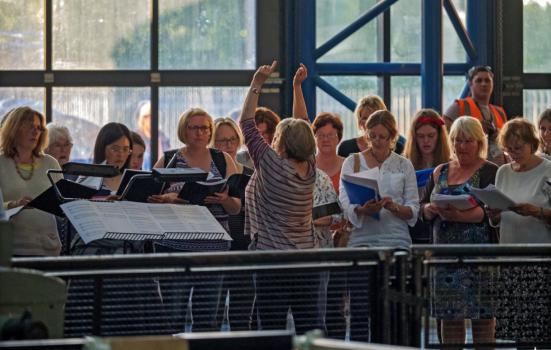How can arts organisations present their offer more effectively to public service commissioners? Five pilot consortia have been working to do just that and Jessica Harris reports on what they’ve learned.

John Saunders
Over the past nine months the Cultural Commissioning Programme (CCP) has supported five locality project pilots to bring together the arts and cultural sector with leaders and commissioners in local authorities, public health, clinical commissioning groups (CCGs) and hospital trusts to connect and identify opportunities for partnership working.
By collaborating, the arts and cultural consortia showed that they are interested, engaged and approachable
Supported by CCP’s facilitator, each locality (Birmingham, Derby, Manchester, Torbay and York) has undertaken preliminary research to develop a picture of the social and health challenges and the priorities for public services. They then held meetings with leaders and senior commissioners in public health, adults, children’s and family services to get a view of the priorities and gauge the appetite for working with arts and cultural organisations. The following priorities were identified:
- preventing health and social problems before they arise by supporting wellbeing and enabling healthy lifestyles
- support for people living with mental health issues
- shifting to non-medical approaches to support individuals
- building strong communities
- reducing isolation
- support for vulnerable children
- support for people with dementia.
The keys to success
A number of factors helped the arts and cultural organisations approach the leaders and commissioners in these pilot areas. They worked together as a consortium or a network, making them more visible to public service leaders. By collaborating, they broadened their offer of artforms, skills and approaches. In some areas, partnering with other third-sector organisations also strengthened their capacity and visibility.
Each consortium has made good use of data on the locality and its communities so it was well-informed. (See below for more on the key sources of data.)
The arts and cultural consortia began to take part in market engagement events and local strategic or partnership groups. Commissioners use these for networking with potential providers and to discuss service design before a tender is issued. (More detail on these events and groups is below.)
The arts and cultural organisations assessed how their work related to local priorities and were better able to present the contribution they could make to people, community and place. Plans produced by the pilots can be found here.
In meetings with public service leaders and commissioners, arts and cultural organisations have looked at their locality through the ‘lens’ of the commissioners. As a result many commissioners were more receptive and open to innovation and creativity.
New relationships
A common message from commissioners was that they didn’t know how to make contact with their local cultural sector and didn’t have an overview of what it could offer. By collaborating, the arts and cultural consortia showed that they are interested, engaged and approachable. Collaboration between arts and cultural providers also makes it easier for commissioners to signpost other providers to them, such as charities or other voluntary organisations that may be looking for sub-contractors to help deliver services.
The process has contributed to the arts and cultural organisations’ knowledge of social and health challenges. It is leading to new relationships and conversations with people who plan, commission and manage a wide range of public services and budgets. Most of the pilots have been invited to present to their local health and wellbeing board, the strategic body where health and care leaders work together to improve the health and wellbeing of their local population, reduce health inequalities and encourage commissioners to work in a more joined-up way.
While the rate of progress of the pilots has varied depending on local circumstances, the positioning of their collective offer is being taken seriously. Even if local budgets are tight, knowing about the offer is enabling commissioners to access external funds through partnerships. Each consortium is being seen as an asset, and as part of the solution to the challenge of engaging and empowering people, community and place.
Key sources of data
- Joint strategic needs assessment (JSNA): Produced jointly by local authorities and CCGs, these identify current and future health and wellbeing needs of the local population and inform commissioning priorities. Read York’s JSNA as an example.
- Health profiles: Produced annually by Public Health England, these give a snapshot overview of health for each local authority in England.
- Director of Public Health’s annual reports: These outline health statistics for a local authority area and describe how public health teams are tackling issues, together with partners from other sectors. Read this example from South Gloucestershire.
- CCG strategic plans: These are medium-term plans which outline local health challenges and strategies. Read this example for South Derbyshire CCG.
- Market position statements: Produced by local authorities, these outline the outcomes the council wants to achieve, types of partners it wishes to work with, and how interested partners can contact it. Manchester’s market position statement is an example.
- Health and wellbeing boards: These are the priorities and plans of each of the boards in England.
- Who’s who in health and social care in the English regions: Information on which CCGs operate in each area.
Market development events and local strategic or partnership groups
- Local authorities usually announce their market development events through their online procurement portal and many also have provider forums. Register to keep informed.
- Voluntary Service Councils often work with local authorities and CCGs to provide a conduit to voluntary organisations in their areas and are a source of information and a means of engagement.
- Local authorities often facilitate user forums as a way of engaging with service users, such as older people’s forums and mental health forums, to consult on needs and service provision.
- CCGs tend to have less formalised structures for market engagement, so a direct approach may be best.
Jessica Harris is Cultural Commissioning Programme Manager at the National Council for Voluntary Organisations.
The Cultural Commissioning Programme is funded by Arts Council England. It works with the arts and cultural sector, commissioners and policy makers to strengthen commissioning of arts and culture, and deliver better outcomes for people and communities. It is delivered by a partnership of National Council for Voluntary Organisations (lead partner), New Philanthropy Capital and New Economics Foundation. For resources, case studies and sources of evidence curated by CCP click here.
A second phase of the CCP will run from this July to December 2017. It will maintain and develop influence nationally to encourage the wider support for this field of work and gain recognition for the collaborations which have developed.
This article, sponsored and contributed by the Cultural Commissioning Programme, is in a series exploring opportunities for arts organisations, museums and library services to engage in public service commissioning.





